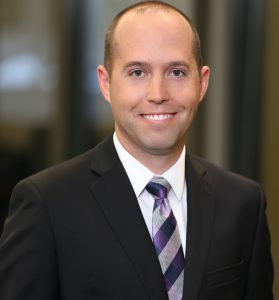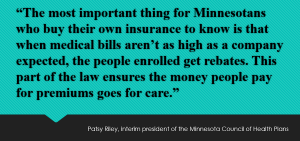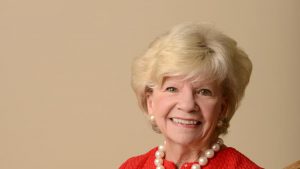The Minnesota Council of Health Plans today announced that Lucas Nesse has been named its president and chief executive officer. Nesse was most recently with the Minnesota Business Partnership and brings deep experience in public policy and team leadership.

In his five years at the Business Partnership, Nesse served as director of health policy and grassroots advocacy and was instrumental in the development and implementation of strategic policy initiatives and advocacy plans. Prior to that role, Nesse served in the Minnesota Legislature for 10 years, serving as the legislative director and chief advisor to the Senate leadership during his last four years.
“We are excited for Lucas to step into this new role,” said John Naylor, Minnesota Council of Health Plans board chair and president, and president and CEO of Medica. “I’ve personally worked with Lucas and have seen first-hand his passion, expertise and ability to build relationships across the aisle to further important health initiatives for our state. I look forward to the many contributions Lucas will bring to Minnesota Council of Health Plans, its members and the greater community.”
Nesse earned a Bachelor of Arts in Political Science from Gustavus Adolphus College and his Juris Doctor from William Mitchell College of Law. He currently resides in Lake Elmo with his wife and two children.
Nesse will begin his new role on Oct. 21. He replaces Patsy Riley, who has served as interim President and CEO since last March.
Starting next week, a uniform preferred drug list is required by the Department of Human Services.
This means more than 55,200 people who get care through Prepaid Medical Assistance Program and MinnesotaCare may have to change medications the next time they need a refill. The change also applies to people with Minnesota Senior Care Plus and Special Needs BasicCare who do not get their drugs from Medicare. In all, nearly 74,000 prescriptions will likely need to change over time.
Letters have been sent to people who may have to change drugs. The letter lists the current drugs the person takes that may need to change. It also suggests similar drugs that meet the state’s new rule. Medical supplies like diabetes test strips may also need to change. Treatment for people with diabetes, asthma and mental illness are three of the common illnesses where different drugs may be required.
People who received a letter should call their doctor or pharmacy. Some drugs can be changed with a phone call. Others require the patient to be seen by a doctor or someone else who provides their care. If an individual’s health does not allow him/her to switch to a drug on the new list, ask for approval to continue with the current medication.
Here are more details on what changes starting July 1, and what doesn’t change.
Here is a number to call at each of the Council’s health insurers if you have questions about your medications.
Here’s a Council letter to the Minnesota Department of Human Services highlighting problems that may come up as this change takes place.
The Center for Community Health—a health improvement initiative involving members from local public health agencies, health insurers, hospitals and health systems—works on activities to improve mental health awareness and understanding across the Twin Cities. On its website, CCH offers background and facts, resources such as mental health first aid training and Make it Ok, a proclamation, and social media messages for all organizations that want to help increase understanding and awareness on the importance of mental health.
Volatility continued for people who buy their own insurance; some to receive rebates
The Minnesota Council of Health Plans announced today its member companies paid $27.7 billion in medical bills for more than 5.5 million people in 2018. Council member insurers help Minnesotans in every county across the state pay for the care they need, no matter how they get their insurance.
In aggregate across all ways people get insurance, and in all locations, per person medical bills were up 3 percent on average over the previous year. Insurers collected $31 billion in premium revenue and after paying all expenses, ended the year with an operating gain of 1.6 percent of revenue, or $500 million.
Reinsurance paid high medical bills for Minnesotans who bought their own insurance
Minnesota’s premium security program, also known as reinsurance, helped pay high medical bills so the expenses weren’t added to people’s premiums. The help from the state meant monthly premiums in 2018 and 2019 were 20 percent lower on average. In fact, with the help of reinsurance Minnesota’s premiums in 2019 are the lowest in the country and enrollment from March 2018 to March 2019 remained steady.
While premiums decreased, medical bills did not. Monthly medical bills for these Minnesotans increased 8 percent per person over 2017. In all, these Minnesotans paid $867 million in premiums and had medical bills that reached $686 million. Since 2014, enrollment, premiums and medical bills have been difficult to predict. Between 2014 and 2018, total expenses have surpassed revenue by $395 million, a five-year average margin of -7 percent of premium revenue.
Two health insurers expect to send rebates to people who bought policies where medical bills weren’t as high as predicted when the rates were approved in 2017. Setting accurate premiums for these Minnesotans continued to be difficult as margins averaged 23 percent of premium revenue industry wide.
“The most important thing for Minnesotans to know is that when medical bills aren’t as high as a company expected, the people enrolled get rebates. This part of the law ensures the money people pay for premiums goes for care,” said Patsy Riley, interim president of the Minnesota Council of Health Plans.
St. Paul, Minn.—Minnesota Council of Health Plans announced today that Patsy Riley will serve as the organization’s interim president and chief executive officer. Riley steps in for Jim Schowalter, who is leaving the Council at the end of the month after four years as its leader.
“We’re excited to bring on board a respected industry leader to help guide the Council through this important transition,” said Council Board Chair Mark Traynor, UCare’s president and chief executive officer. “Patsy has the relationships, expertise and experience to work with our board, staff, regulators and community partners to ensure our work continues as the search for a permanent leader moves forward.”

Traynor said the Council has already begun the search process. Riley will remain with the Council until a
new leader is in place.
Riley, who will assume the Council leadership position March 4, said, “I’ve long admired the work of the Council and the people who do that work. As a former Council board member, I am passionate about the organization and look forward to helping to guide the work.”
In 2018, Riley received the Pinnacle Award from the Women’s Health Leadership Trust in recognition of her lifetime achievements in health care in Minnesota. Her experiences include executive roles at Blue Cross and Blue Shield of Minnesota, Stratis Health and Medica. Early in her career, Riley worked with the Minnesota Coalition on Health, Altcare, Ebenezer Society and the Minnesota Board on Aging. She was honored by the Business Journal as a Women in Business Award Winner in 2016. She has a master’s degree in public affairs from the University of Minnesota, and lives in Wayzata, Minn.
The Council works with some of our nation’s best health insurers to help make sure Minnesotans get the care they need today and in the future. Council members serve communities, not Wall Street shareholders.
-30-
Statement by Council President Jim Schowalter
on the budget proposal by Gov. Walz
St. Paul, Minn.—Significant health insurance proposals in the budget announced today by Minnesota Gov. Tim Walz recognize the fact that there is a lot of work to do to help make sure Minnesotans get the care they need now and in the future.
The Council now begins the work of digging into each of the Governor’s ideas, along with proposals from others, to understand how decisions facing policymakers in St. Paul will shape the care Minnesotans get.
“No matter how you get help paying for care—through insurance at work or a policy you buy on your own; Medicare, Medicaid or MinnesotaCare—may be affected by proposals making their way through the legislature,” said Jim Schowalter, president of the Minnesota Council of Health Plans. “We’ll work with leaders in state agencies to analyze proposals to help decision-makers understand the connections, possible trade offs and outcomes that aren’t intended.”
“The proposals from Gov. Walz drive home the fact that there isn’t one approach that will solve the problems facing Minnesotans,” Schowalter continued. “While the Council has considered some of these proposals previously, we will now be able to dig into the detail offered by Gov. Walz.
“The rising expense of care has real consequences for all of us. Stabilizing options and making care less expensive for all Minnesotans is the biggest challenge we all face,” Schowalter concluded. “The best health care in the world doesn’t do us any good if we can’t afford it.
-30-
See the statement, here.
It’s not often there is good news about the expense of medical care and health insurance premiums. But today the Minnesota Council of Health Plans has good news. Expenses in the state program that helps pay high medical bills for people who buy their own insurance are about half the amount expected.
That means there is enough money left over to extend the help into 2020 and 2021.
This year and last, our state’s Premium Security Plan, also known as reinsurance, lowered premiums for people who buy their own health insurance.
That decrease was 20 percent, on average, according to the Minnesota Department of Commerce,
That reduction was just what lawmakers had planned.
The only surprise is that it looks as if it will cost about half as much as expected. In the program’s first nine month just 31 percent of the available money was needed for medical bills. Of course, bills are still coming in for care people needed this past October, November and December, but the totals won’t come close to the $271 million appropriated at the start.
Policy makers should use any leftover money to continue to help people who buy their own insurance.
Here’s how it works and why policymakers need to keep it for now.
[et_pb_section fb_built=”1″ _builder_version=”3.22″][et_pb_row _builder_version=”3.25″ background_size=”initial” background_position=”top_left” background_repeat=”repeat”][et_pb_column type=”4_4″ _builder_version=”3.25″ custom_padding=”|||” custom_padding__hover=”|||”][et_pb_text _builder_version=”4.6.6″ hover_enabled=”0″ sticky_enabled=”0″]
By Jim Schowalter, Council president
Leaving this job is difficult.
Here, Minnesotans who understand their work in depth come together across traditional boundaries to make health care better. People who work with hospitals, clinics, the state, community groups and other organizations share the same goals. While sometimes we disagree, we all want to make meaningful changes that improve Minnesotans’ lives. That’s the legacy of our nonprofit-led health care system.
Before I leave at the end of the month, the Council’s strong and experienced staff and I will keep moving this important work forward. That includes:
- Making sure policymakers understand that Minnesotans who buy insurance on their own need the state’s Premium Security Plan, also known as reinsurance, extended to avoid huge premium increases.
- The provider tax needs to continue because it helps makes sure all Minnesotans can get care.
- Continuing our work on prescription drug prices and dozens of other policy issues the Council evaluates to help figure out what changes mean for Minnesotans across the state.
Making health care more affordable is important work, and I’ll continue doing that when I join HealthPartners provider partnerships’ team this spring.
I’m confident the Council’s next leader will continue the organization’s 34-year commitment to creating a space where competitors work together to make sure all Minnesotans get the care they need today and into the future. It’s important work and I’m grateful to have been a part of it for the past four years.
[/et_pb_text][/et_pb_column][/et_pb_row][/et_pb_section]
Minnesota Council of Health Plans Board begins search for new leader
Minnesota Council of Health Plans announced today that Jim Schowalter has resigned as the organization’s president and chief executive officer. Council Board Chair Mark Traynor said the search for Schowalter’s successor will begin immediately.
“We thank Jim for his collaborative leadership and commitment to creating a space where Council members put aside competitive concerns and look at how Minnesotans get care and how we can do better, Traynor said. “Challenges facing Minnesotans who need care continue, and fortunately we have a strong, experienced team at the Council who will continue our work.”
In March, Schowalter will join HealthPartners as senior vice president of provider partnerships.
The Minnesota Council of Health is a 34-year effort to improve care for Minnesotans. Together, with others in the community, we work to solve problems that are in the way of making sure we get the care we need now and in the future.